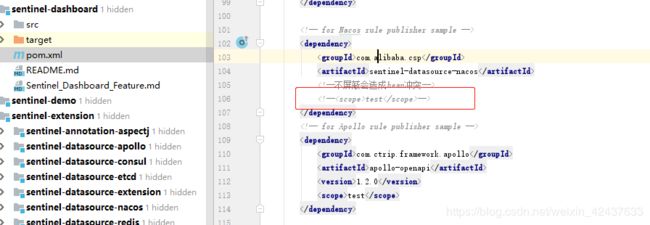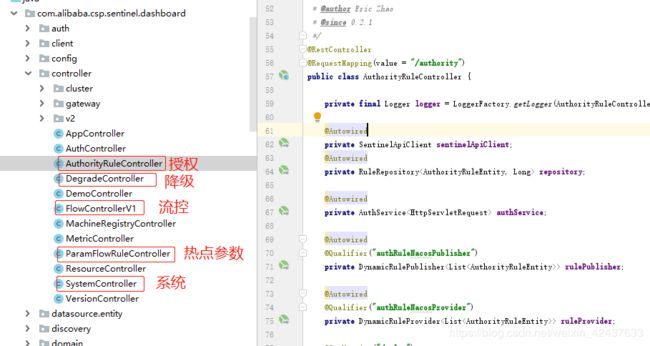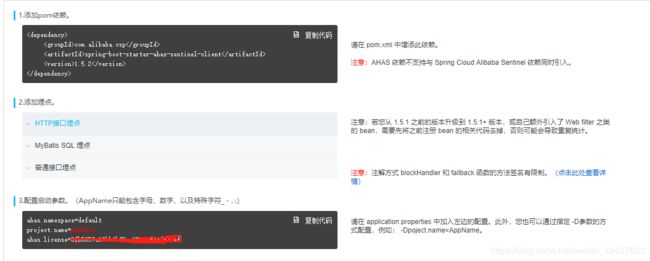Sentinel规则持久化改造(pull+push+Ahas)
Sentinel规则持久化改造(pull+push+Ahas)
每天多学一点点~
话不多说,这就开始吧…
文章目录
- Sentinel规则持久化改造(pull+push+Ahas)
- 1.前言
- 2. 官网参考
- 3. 原生模式
- 4. PULL 拉模式
- 5. push 推模式
- 6. 阿里云Ahas
- 7.结语
1.前言
之前学习过阿里的sentinel组件,但是重启之后,配置的规则都消失了。于是乎上网找了点资料,自己也来对sentinel持久化改造一下,这里记录一下过程。
以sentinel 1.7.0 版本 为例
sentinel git地址
2. 官网参考
在生产环境中使用 Sentinel
官网上提供了三种方式。根据官网提供资料,一个个来
3. 原生模式
Dashboard的推送规则方式是通过 API 将规则推送至客户端并直接更新到内存
优缺点:这种做法的好处是简单,无依赖;坏处是应用重启规则就会消失,仅用
于简单测试,不能用于生产环境
4. PULL 拉模式

首先 Sentinel 控制台通过 API 将规则推送至客户端并更新到内存中,接着注册
的写数据源会将新的规则保存到本地的文件中。使用 pull 模式的数据源时一般
不需要对 Sentinel 控制台进行改造。
这种实现方法好处是简单,不引入新的依赖,坏处是无法保证监控数据的一致性。
(定时功能周期默认3s)

-
通过SPI扩展机制进行扩展,写一个拉模式的实现类
在微服务共工程 resources 目录下 新建
在 工程下创建META-INF 下创建services目录
文件名称是 com.alibaba.csp.sentinel.init.InitFunc
内容 com.zjq.persistence.PullModeByFileDataSource # 指向自己的类 -
PullModeByFileDataSource 类,实现InitFunc 接口
这里就是和官网上的例子差不多,拿过来改一改
这里以 流控规 为例
PullModeByFileDataSource 类
@Slf4j
public class PullModeByFileDataSource implements InitFunc {
private static final SimpleDateFormat sdf = new SimpleDateFormat("yyyy/MM/dd HH:mm:ss");
@Override
public void init() throws Exception {
log.info("time:{}读取配置",sdf.format(new Date()));
try {
//创建文件存储目录(若路径不存在就创建路径)
RuleFileUtils.mkdirIfNotExits(PersistenceRuleConstant.storePath);
//创建规则文件()
RuleFileUtils.createFileIfNotExits(PersistenceRuleConstant.rulesMap);
// 处理流控规则逻辑
dealFlowRules();
// 处理降级规则
dealDegradeRules();
// 处理系统规则
dealSystemRules();
// 热点参数规则
dealParamFlowRules();
dealAuthRules();
}catch (Exception e) {
log.error("错误原因:{}",e);
}
}
/**
* 方法实现说明:处理流控规则逻辑
* @author:zjq
* @return: void
* @exception: FileNotFoundException
* @date:2020/05/3013:26
*/
private void dealFlowRules() throws FileNotFoundException {
String ruleFilePath = PersistenceRuleConstant.rulesMap.get(PersistenceRuleConstant.FLOW_RULE_PATH).toString();
//创建流控规则的可读数据源
ReadableDataSource> flowRuleRDS = new FileRefreshableDataSource(
ruleFilePath,RuleListParserUtils.flowRuleListParser
);
// 将可读数据源注册至FlowRuleManager 这样当规则文件发生变化时,就会更新规则到内存
FlowRuleManager.register2Property(flowRuleRDS.getProperty());
WritableDataSource> flowRuleWDS = new FileWritableDataSource>(
ruleFilePath, RuleListParserUtils.flowFuleEnCoding
);
// 将可写数据源注册至 transport 模块的 WritableDataSourceRegistry 中.
// 这样收到控制台推送的规则时,Sentinel 会先更新到内存,然后将规则写入到文件中.
WritableDataSourceRegistry.registerFlowDataSource(flowRuleWDS);
}
。。。。。 其他 规则差不多
}
PersistenceRuleConstant Sentinel 规则持久化 常量配置类
public class PersistenceRuleConstant {
/**
* 存储文件路径
*/
public static final String storePath = System.getProperty("user.home")+"\\sentinel\\rules\\";
/**
* 各种存储sentinel规则映射map
*/
public static final Map rulesMap = new HashMap();
//流控规则文件
public static final String FLOW_RULE_PATH = "flowRulePath";
//降级规则文件
public static final String DEGRAGE_RULE_PATH = "degradeRulePath";
//授权规则文件
public static final String AUTH_RULE_PATH = "authRulePath";
//系统规则文件
public static final String SYSTEM_RULE_PATH = "systemRulePath";
//热点参数文件
public static final String HOT_PARAM_RULE = "hotParamRulePath";
static {
rulesMap.put(FLOW_RULE_PATH,storePath+"flowRule.json");
rulesMap.put(DEGRAGE_RULE_PATH,storePath+"degradeRule.json");
rulesMap.put(SYSTEM_RULE_PATH,storePath+"systemRule.json");
rulesMap.put(AUTH_RULE_PATH,storePath+"authRule.json");
rulesMap.put(HOT_PARAM_RULE,storePath+"hotParamRule.json");
}
}
RuleFileUtils sentinel 规则文件存储工具类
@Slf4j
public class RuleFileUtils {
/**
* 方法实现说明:若路径不存在就创建路径
* @author:zjq
* @param filePath:文件存储路径
* @return: void
* @exception: IOException
* @date:2020/05/3016:32
*/
public static void mkdirIfNotExits(String filePath) throws IOException {
File file = new File(filePath);
if(!file.exists()) {
log.info("创建Sentinel规则目录:{}",filePath);
file.mkdirs();
}
}
/**
* 方法实现说明:若文件不存在就创建路径
* @author:zjq
* @param ruleFileMap 规则存储文件
* @return: void
* @exception: IOException
* @date:2020/05/3016:32
*/
public static void createFileIfNotExits(Map ruleFileMap) throws IOException {
Set ruleFilePathSet = ruleFileMap.keySet();
Iterator ruleFilePathIter = ruleFilePathSet.iterator();
while (ruleFilePathIter.hasNext()) {
String ruleFilePathKey = ruleFilePathIter.next();
String ruleFilePath = PersistenceRuleConstant.rulesMap.get(ruleFilePathKey).toString();
File ruleFile = new File(ruleFilePath);
if(ruleFile.exists()) {
log.info("创建Sentinel 规则文件:{}",ruleFile);
ruleFile.createNewFile();
}
}
}
}
RuleListParserUtils 规则列表解析工具类
public class RuleListParserUtils {
/**
* 流控列表解析器
*/
public static final Converter> flowRuleListParser = new Converter>() {
@Nullable
@Override
public List convert(String source) {
return JSON.parseObject(source, new TypeReference>() {});
}
};
/**
* 流控列表 编码器
*/
public static final Converter,String> flowFuleEnCoding= new Converter,String>() {
@Nullable
@Override
public String convert(List source) {
return JSON.toJSONString(source);
}
};
...... 其他同理
}
这样,会在我们的 配置的路径地下生成json文件

json文件
[{
"clusterConfig": {
"fallbackToLocalWhenFail": true,
"sampleCount": 10,
"strategy": 0,
"thresholdType": 0,
"windowIntervalMs": 1000
},
"clusterMode": false,
"controlBehavior": 0,
"count": 1.0,
"grade": 1,
"limitApp": "default",
"maxQueueingTimeMs": 500,
"resource": "/selectOrderInfoById/1",
"strategy": 0,
"warmUpPeriodSec": 10
}]
这样,pull模式的持久化改造就完成了。
但是也如上文说的,pull 模式的自身缺点 :因为有定时任务 ,若 时间太短,服务器受不了;时间太长,有延迟
5. push 推模式
这边已nacos为例,也是官网推荐的 生产环境 使用
-
控制台推送规则:
将规则推送到Nacos或其他远程配置中心。Sentinel客户端链接Nacos,获取规则配置;并监听Nacos配置变化,如发生变化,就更新本地缓存(从而让本地缓存总是和Nacos一致) -
控制台监听Nacos配置变化,如发生变化就更新本地缓存(从而让控制台本地缓存总是和Nacos一致)
这里用sentinel1.7.0 版本为例
代码改造:
- 去掉 sentinel-dashboard 工程的pom中 test

- 控制台源码改造
DynamicRuleProvider:从Nacos上读取配置
DynamicRulePublisher:将规则推送到Nacos上
在sentinel-dashboard工程目录com.alibaba.csp.sentinel.dashboard.rule 下创建一个Nacos的包,
然后把我们的各个场景的配置规则类写道该包下,如下图


2.1 将test下的NacosConfig 复制到 nacos包下 ,写入我们自己的nacos地址
其实源码中的 com.alibaba.csp.sentinel.dashboard.rule.nacos 目录下 已经帮我们写了示例,copy一下改一改就行。
NacosConfig 类
/**
* @author Eric Zhao
* @since 1.4.0
*/
@Configuration
public class NacosConfig {
/**
* 流控规则
* @return
*/
@Bean
public Converter, String> flowRuleEntityEncoder() {
return JSON::toJSONString;
}
@Bean
public Converter> flowRuleEntityDecoder() {
return s -> JSON.parseArray(s, FlowRuleEntity.class);
}
/**
* 授权规则
* @return
*/
@Bean
public Converter, String> authorRuleEntityEncoder() {
return JSON::toJSONString;
}
@Bean
public Converter> authorRuleEntityDecoder() {
return s -> JSON.parseArray(s, AuthorityRuleEntity.class);
}
/**
* 降级规则
* @return
*/
@Bean
public Converter, String> degradeRuleEntityEncoder() {
return JSON::toJSONString;
}
@Bean
public Converter> degradeRuleEntityDecoder() {
return s -> JSON.parseArray(s, DegradeRuleEntity.class);
}
/**
* 热点参数 规则
* @return
*/
@Bean
public Converter, String> paramRuleEntityEncoder() {
return JSON::toJSONString;
}
@Bean
public Converter> paramRuleEntityDecoder() {
return s -> JSON.parseArray(s, ParamFlowRuleEntity.class);
}
/**
* 系统规则
* @return
*/
@Bean
public Converter, String> systemRuleEntityEncoder() {
return JSON::toJSONString;
}
@Bean
public Converter> systemRuleEntityDecoder() {
return s -> JSON.parseArray(s, SystemRuleEntity.class);
}
/**
* 网关API
* @return
* @throws Exception
*/
@Bean
public Converter,String> apiDefinitionEntityEncoder() {
return JSON::toJSONString;
}
@Bean
public Converter> apiDefinitionEntityDecoder(){
return s -> JSON.parseArray(s,ApiDefinitionEntity.class);
}
/**
* 网关flowRule
* @return
* @throws Exception
*/
@Bean
public Converter,String> gatewayFlowRuleEntityEncoder() {
return JSON::toJSONString;
}
@Bean
public Converter> gatewayFlowRuleEntityDecoder(){
return s -> JSON.parseArray(s,GatewayFlowRuleEntity.class);
}
@Bean
public ConfigService nacosConfigService() throws Exception {
return ConfigFactory.createConfigService("47.111.191.111");
}
}
2.2 以FlowRule为例,配置Publisher和Provider
将test下的FlowRuleNacosPublisher 和 FlowRuleNacosProvider 复制到 nacos 包下
2.3 修改流控规则 FlowControllerV1
2.3.1 添加我们刚才复制来的 Publisher 和 Provider
//添加我们自己写的ruleProvider
@Autowired
@Qualifier("flowRuleNacosProvider")
private DynamicRuleProvider> ruleProvider;
//添加我们自己写的 publisher
@Autowired
@Qualifier("flowRuleNacosPublisher")
private DynamicRulePublisher> rulePublisher;
2.3.2 新增推送到nacos的方法
/**
* 原方法
* @param app
* @param ip
* @param port
* @return
*/
private boolean publishRules(String app, String ip, Integer port) {
List rules = repository.findAllByMachine(MachineInfo.of(app, ip, port));
return sentinelApiClient.setFlowRuleOfMachine(app, ip, port, rules);
}
/**
* 我们自己的publishRules ,将规则推送到 nacos
* @param app
* @throws Exception
*/
private void publishRules(String app) throws Exception {
List rules = repository.findAllByApp(app);
rulePublisher.publish(app,rules);
}
2.3.4 修改FlowControllerV1
1 将原来的 List rules = sentinelApiClient.fetchFlowRuleOfMachine(app, ip, port); 换成从nacos中获取
2 将 保存后的会泽推送到nacos 即 publishRules(entity.getApp());
@RestController
@RequestMapping(value = "/v1/flow")
public class FlowControllerV1 {
private final Logger logger = LoggerFactory.getLogger(FlowControllerV1.class);
@Autowired
private InMemoryRuleRepositoryAdapter repository;
@Autowired
private AuthService authService;
//添加我们自己写的ruleProvider
@Autowired
@Qualifier("flowRuleNacosProvider")
private DynamicRuleProvider> ruleProvider;
//添加我们自己写的 publisher
@Autowired
@Qualifier("flowRuleNacosPublisher")
private DynamicRulePublisher> rulePublisher;
@Autowired
private SentinelApiClient sentinelApiClient;
@GetMapping("/rules")
public Result> apiQueryMachineRules(HttpServletRequest request,
@RequestParam String app,
@RequestParam String ip,
@RequestParam Integer port) {
AuthUser authUser = authService.getAuthUser(request);
authUser.authTarget(app, PrivilegeType.READ_RULE);
if (StringUtil.isEmpty(app)) {
return Result.ofFail(-1, "app can't be null or empty");
}
if (StringUtil.isEmpty(ip)) {
return Result.ofFail(-1, "ip can't be null or empty");
}
if (port == null) {
return Result.ofFail(-1, "port can't be null");
}
try {
//List rules = sentinelApiClient.fetchFlowRuleOfMachine(app, ip, port);
// 去nacos上获取配置规则
List rules = ruleProvider.getRules(app);
rules = repository.saveAll(rules);
return Result.ofSuccess(rules);
} catch (Throwable throwable) {
logger.error("Error when querying flow rules", throwable);
return Result.ofThrowable(-1, throwable);
}
}
private Result checkEntityInternal(FlowRuleEntity entity) {
if (StringUtil.isBlank(entity.getApp())) {
return Result.ofFail(-1, "app can't be null or empty");
}
if (StringUtil.isBlank(entity.getIp())) {
return Result.ofFail(-1, "ip can't be null or empty");
}
if (entity.getPort() == null) {
return Result.ofFail(-1, "port can't be null");
}
if (StringUtil.isBlank(entity.getLimitApp())) {
return Result.ofFail(-1, "limitApp can't be null or empty");
}
if (StringUtil.isBlank(entity.getResource())) {
return Result.ofFail(-1, "resource can't be null or empty");
}
if (entity.getGrade() == null) {
return Result.ofFail(-1, "grade can't be null");
}
if (entity.getGrade() != 0 && entity.getGrade() != 1) {
return Result.ofFail(-1, "grade must be 0 or 1, but " + entity.getGrade() + " got");
}
if (entity.getCount() == null || entity.getCount() < 0) {
return Result.ofFail(-1, "count should be at lease zero");
}
if (entity.getStrategy() == null) {
return Result.ofFail(-1, "strategy can't be null");
}
if (entity.getStrategy() != 0 && StringUtil.isBlank(entity.getRefResource())) {
return Result.ofFail(-1, "refResource can't be null or empty when strategy!=0");
}
if (entity.getControlBehavior() == null) {
return Result.ofFail(-1, "controlBehavior can't be null");
}
int controlBehavior = entity.getControlBehavior();
if (controlBehavior == 1 && entity.getWarmUpPeriodSec() == null) {
return Result.ofFail(-1, "warmUpPeriodSec can't be null when controlBehavior==1");
}
if (controlBehavior == 2 && entity.getMaxQueueingTimeMs() == null) {
return Result.ofFail(-1, "maxQueueingTimeMs can't be null when controlBehavior==2");
}
if (entity.isClusterMode() && entity.getClusterConfig() == null) {
return Result.ofFail(-1, "cluster config should be valid");
}
return null;
}
@PostMapping("/rule")
public Result apiAddFlowRule(HttpServletRequest request, @RequestBody FlowRuleEntity entity) {
AuthUser authUser = authService.getAuthUser(request);
authUser.authTarget(entity.getApp(), PrivilegeType.WRITE_RULE);
Result checkResult = checkEntityInternal(entity);
if (checkResult != null) {
return checkResult;
}
entity.setId(null);
Date date = new Date();
entity.setGmtCreate(date);
entity.setGmtModified(date);
entity.setLimitApp(entity.getLimitApp().trim());
entity.setResource(entity.getResource().trim());
try {
entity = repository.save(entity);
//推送规则并保存
publishRules(entity.getApp());
} catch (Throwable throwable) {
logger.error("Failed to add flow rule", throwable);
return Result.ofThrowable(-1, throwable);
}
if (!publishRules(entity.getApp(), entity.getIp(), entity.getPort())) {
logger.error("Publish flow rules failed after rule add");
}
return Result.ofSuccess(entity);
}
@PutMapping("/save.json")
public Result updateIfNotNull(HttpServletRequest request, Long id, String app,
String limitApp, String resource, Integer grade,
Double count, Integer strategy, String refResource,
Integer controlBehavior, Integer warmUpPeriodSec,
Integer maxQueueingTimeMs) {
AuthUser authUser = authService.getAuthUser(request);
authUser.authTarget(app, PrivilegeType.WRITE_RULE);
if (id == null) {
return Result.ofFail(-1, "id can't be null");
}
FlowRuleEntity entity = repository.findById(id);
if (entity == null) {
return Result.ofFail(-1, "id " + id + " dose not exist");
}
if (StringUtil.isNotBlank(app)) {
entity.setApp(app.trim());
}
if (StringUtil.isNotBlank(limitApp)) {
entity.setLimitApp(limitApp.trim());
}
if (StringUtil.isNotBlank(resource)) {
entity.setResource(resource.trim());
}
if (grade != null) {
if (grade != 0 && grade != 1) {
return Result.ofFail(-1, "grade must be 0 or 1, but " + grade + " got");
}
entity.setGrade(grade);
}
if (count != null) {
entity.setCount(count);
}
if (strategy != null) {
if (strategy != 0 && strategy != 1 && strategy != 2) {
return Result.ofFail(-1, "strategy must be in [0, 1, 2], but " + strategy + " got");
}
entity.setStrategy(strategy);
if (strategy != 0) {
if (StringUtil.isBlank(refResource)) {
return Result.ofFail(-1, "refResource can't be null or empty when strategy!=0");
}
entity.setRefResource(refResource.trim());
}
}
if (controlBehavior != null) {
if (controlBehavior != 0 && controlBehavior != 1 && controlBehavior != 2) {
return Result.ofFail(-1, "controlBehavior must be in [0, 1, 2], but " + controlBehavior + " got");
}
if (controlBehavior == 1 && warmUpPeriodSec == null) {
return Result.ofFail(-1, "warmUpPeriodSec can't be null when controlBehavior==1");
}
if (controlBehavior == 2 && maxQueueingTimeMs == null) {
return Result.ofFail(-1, "maxQueueingTimeMs can't be null when controlBehavior==2");
}
entity.setControlBehavior(controlBehavior);
if (warmUpPeriodSec != null) {
entity.setWarmUpPeriodSec(warmUpPeriodSec);
}
if (maxQueueingTimeMs != null) {
entity.setMaxQueueingTimeMs(maxQueueingTimeMs);
}
}
Date date = new Date();
entity.setGmtModified(date);
try {
entity = repository.save(entity);
/**
* 自定义推送
*/
publishRules(entity.getApp());
if (entity == null) {
return Result.ofFail(-1, "save entity fail");
}
} catch (Throwable throwable) {
logger.error("save error:", throwable);
return Result.ofThrowable(-1, throwable);
}
if (!publishRules(entity.getApp(), entity.getIp(), entity.getPort())) {
logger.info("publish flow rules fail after rule update");
}
return Result.ofSuccess(entity);
}
@DeleteMapping("/delete.json")
public Result delete(HttpServletRequest request, Long id) {
AuthUser authUser = authService.getAuthUser(request);
if (id == null) {
return Result.ofFail(-1, "id can't be null");
}
FlowRuleEntity oldEntity = repository.findById(id);
if (oldEntity == null) {
return Result.ofSuccess(null);
}
authUser.authTarget(oldEntity.getApp(), PrivilegeType.DELETE_RULE);
try {
repository.delete(id);
//删除nacos上的配置规则
publishRules(oldEntity.getApp());
} catch (Exception e) {
return Result.ofFail(-1, e.getMessage());
}
if (!publishRules(oldEntity.getApp(), oldEntity.getIp(), oldEntity.getPort())) {
logger.info("publish flow rules fail after rule delete");
}
return Result.ofSuccess(id);
}
/**
* 原方法
* @param app
* @param ip
* @param port
* @return
*/
private boolean publishRules(String app, String ip, Integer port) {
List rules = repository.findAllByMachine(MachineInfo.of(app, ip, port));
return sentinelApiClient.setFlowRuleOfMachine(app, ip, port, rules);
}
/**
* 我们自己的publishRules ,将规则推送到 nacos
* @param app
* @throws Exception
*/
private void publishRules(String app) throws Exception {
List rules = repository.findAllByApp(app);
rulePublisher.publish(app,rules);
}
}
其他规则 同理。
2.4 微服务工程改造
2.4.1 增加 sentinel与nacos整合后的依赖
com.alibaba.csp
sentinel-datasource-nacos
2.4.2 yml配置
spring:
datasource:
druid:
...... # 省略db配置
cloud:
nacos:
discovery:
server-addr: localhost:8848
sentinel:
transport:
dashboard: localhost:9999
#namespace: bc7613d2-2e22-4292-a748-48b78170f14c #指定namespace的id
datasource:
# 名称随意
flow:
nacos:
server-addr: localhost:8848
dataId: ${spring.application.name}-flow-rules # 都是在 sentinel源码持久化改造中的规则名称
groupId: SENTINEL_GROUP
rule-type: flow
degrade:
nacos:
server-addr: localhost:8848
dataId: ${spring.application.name}-degrade-rules # 都是在 sentinel源码持久化改造中的规则名称
groupId: SENTINEL_GROUP
rule-type: degrade
system:
nacos:
server-addr: localhost:8848
dataId: ${spring.application.name}-system-rules # 都是在 sentinel源码持久化改造中的规则名称
groupId: SENTINEL_GROUP
rule-type: system
authority:
nacos:
server-addr: localhost:8848
dataId: ${spring.application.name}-authority-rules # 都是在 sentinel源码持久化改造中的规则名称
groupId: SENTINEL_GROUP
rule-type: authority
param-flow:
nacos:
server-addr: localhost:8848
dataId: ${spring.application.name}-param-flow-rules # 都是在 sentinel源码持久化改造中的规则名称
groupId: SENTINEL_GROUP
rule-type: param-flow
application:
name: order-center
server:
port: 8080
#是否开启@SentinelRestTemplate注解
resttemplate:
sentinel:
enabled: true
management:
endpoints:
web:
exposure:
include: '*'
这样到此为止就改造好了
这样无论是重启 nacos也好,sentinel也罢,业务工程也罢,都会实例化~
6. 阿里云Ahas
能用钱解决的事,都不是事情~
ahas开通地址
阿里云ahas文档

选择sdk接入—>springboot接入


随便起一个工程,接入ahas,访问接口

7.结语
世上无难事,只怕有心人,每天积累一点点,fighting!!!




